QSuper's investment strategy in action
17 July 2019
10
min read
QSuper’s Balanced option current 1-year and 10-year performance results are a direct result of the risk-balanced investment strategy QSuper introduced in 2011, with the objective of helping our members achieve strong long-term returns with less risk.
The GFC was a game-changer for QSuper.
We received member feedback in its aftermath that protecting the value of their superannuation accounts from the worst effects of share market downturns was especially important to them. At the same time, they wanted to be able to participate in rising share markets.
Trying to meet those dual expectations required new thinking. Many superannuation funds perform well when share markets are strong, but not so well when they’re down.
Then there are superannuation funds that are good on protection, but not so good on the return side of the equation.
We devoted a lot of research into trying to develop investment strategies that could do both.
Our response, which we began rolling out from 2011, was to invest in a “risk-balanced” way. This was a break from existing industry practice, which was based on specific asset class diversification.
Most recently this has seen QSuper’s Balanced investment option named by Chant West as the top-performing growth option for the 12 months to end June 2019 as well as an industry leader over 10 years.1
What is a "risk-balanced" way
Risk allocation — as it relates to individual asset classes (shares, bonds, property, infrastructure, real estate, private equity, and alternatives) in investment portfolios — can vary significantly from asset allocations.
A representative balanced fund with 52% of the value of the portfolio invested in shares, and other asset classes (Figure 1) looks quite different on a risk allocation basis (Figure 2).
Figure 1: A representative balanced portfolio with 52% allocated to equities
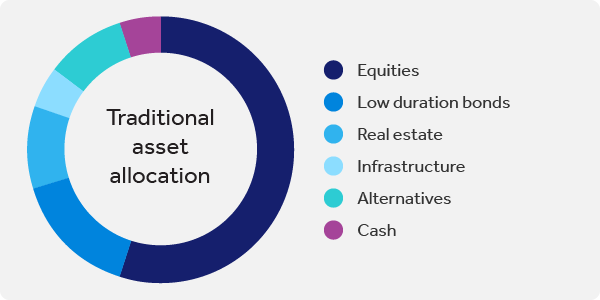
Source: The asset allocation in this chart is for the SuperRatings SR50 Balanced (60-76) Index median fund. SuperRatings does not issue, sell, guarantee or underwrite this product.
It’s important to look under the asset allocation bonnet to uncover the risk allocation. Doing so reveals that the representative balanced fund has very high equity risk – the risk associated with share market investments.
Figure 2: Equity risk of the representative balanced asset allocation = 83% equity risk*
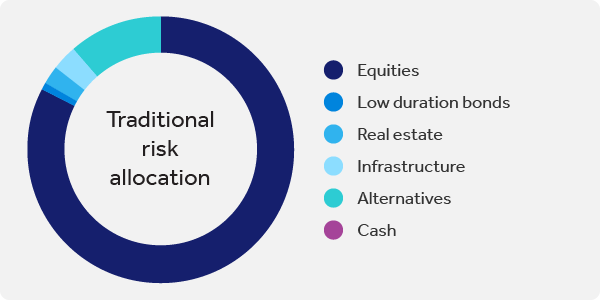
*Risk allocation is defined as contribution to volatility
Source: The risk allocation is based on QSuper analysis of the SuperRatings SR50 Balanced (60-76) Index median fund asset allocation. SuperRatings does not issue, sell, guarantee or underwrite this product.
Rather than exposing members so much to share market ups and downs, QSuper’s Balanced option (Figure 3) provides a more even spread of risks.
We have done this by dialling down equity risk and dialling up risks (and return potential) from other asset classes, led by bonds, while direct infrastructure, real estate, private equity and alternative investments bring their own very different risk and return profiles to portfolios.
Stemming from this risk-balancing, QSuper’s Balanced option generally underperforms rising share markets, but tends to outperform falling share markets.
That’s because asset classes usually don’t move in lock-step. They are usually uncorrelated.
Figure 3: Risk allocation* of QSuper Balanced option is more even
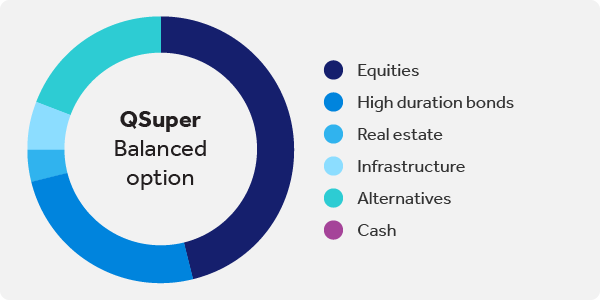
*Risk allocation is defined as contribution to volatility
Source: The asset allocation of the QSuper Balanced option for the accumulation account.
Performance: the strategy in action
The results achieved since 2011 have been encouraging and broadly in line with expectations (Figure 4). Thanks to risk-balanced investing, QSuper’s balanced option is an industry leader for 10-year performance for its investment category1 and has achieved this without violent swings in year-by-year performance.
Figure 4: QSuper Balanced option returns vs. median balanced fund (SR50)
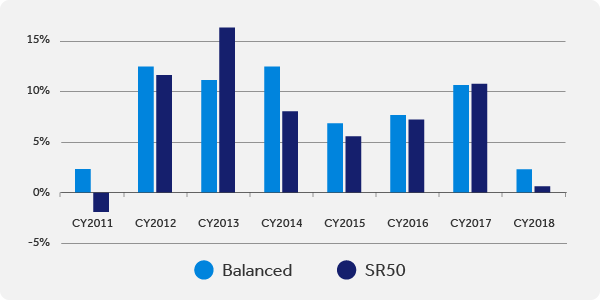
Source: The table above shows the after fees and taxes return for the accumulation account of the QSuper Balanced option. It also shows the after fees and taxes return for the SuperRatings SR50 Balanced (60-76) Index using median returns. SuperRatings does not issue, sell, guarantee or underwrite this product.
Another way of unpacking the Balanced option’s return profile is to look at its performance during periods of share market strength, as well as share market underperformance since 2011.
We’ve picked four periods from 2011 to January 2019 to illustrate risk-balanced investing in action.
Return period 1. 12 April 2011 – 26 September 2011. QSuper balanced falls much less than share markets.
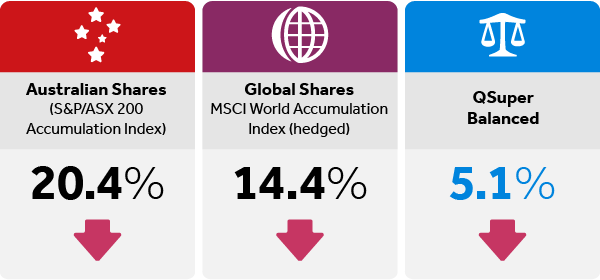
Source: Returns for S&P/ASX 200 Accumulation Index and Global Shares MSCI World Accumulation Index (hedged) are sourced from Bloomberg’s database and have no fees and taxes attributable to them. Return for the accumulation account of the QSuper Balanced option is after fees and taxes.
Returns period 2. 14 March 2012 – 25 June 2012. QSuper Balanced option provides positive return in falling share markets.
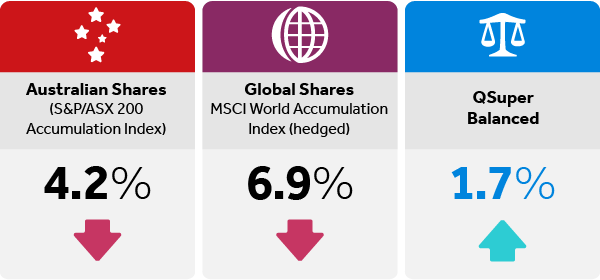
Source: Returns for S&P/ASX 200 Accumulation Index and Global Shares MSCI World Accumulation Index (hedged) are sourced from Bloomberg’s database and have no fees and taxes attributable to them. Return for the accumulation account of the QSuper Balanced option is after fees and taxes.
Returns period 3. 25 November 2016 – 9 January 2018. QSuper Balanced gains less than bullish share markets.
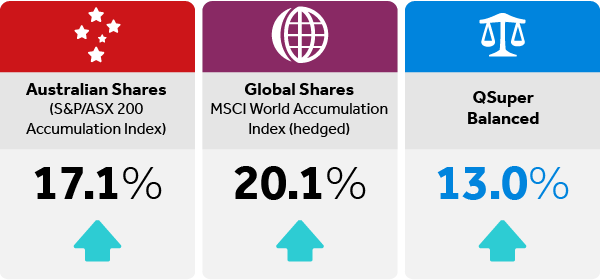
Source: Returns for S&P/ASX 200 Accumulation Index and Global Shares MSCI World Accumulation Index (hedged) are sourced from Bloomberg’s database and have no fees and taxes attributable to them. Return for the accumulation account of the QSuper Balanced option is after fees and taxes.
Returns period 4. 24 September 2018 – 9 January 2019. Share markets fall and QSuper Balanced protects.
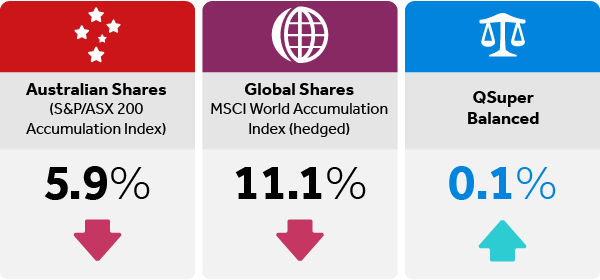
Source: Returns for S&P/ASX 200 Accumulation Index and Global Shares MSCI World Accumulation Index (hedged) are sourced from Bloomberg’s database and have no fees and taxes attributable to them. Return for the accumulation account of the QSuper Balanced option is after fees and taxes.
What this distils down to is that successful long-term investing derives from accumulating small wins, not large gains in one period that could be followed by big reverses in another.
Risk-balanced investing that goes beyond traditional diversification has delivered the goods, so far, for QSuper’s Balanced option and most importantly, is delivering for members invested in the option; aiming for strong long-term performance with less volatility risk.2
Find out what else to consider when comparing Australia’s top performing super funds.
1 Past performance is not a reliable indicator of future performance. QSuper’s Accumulation account, Balanced Option only, ranked fourth. The Chant West data is based on information provided by third parties that is believed to be accurate at 30 June 2019. Based on the returns of investment options in Chant West’s Growth universe over the period to 30 June 2019 with returns reflected after investment fees and tax. Chant West’s Financial Services Guide is available at chantwest.com.au
2
Past performance is not a reliable indicator of future performance.